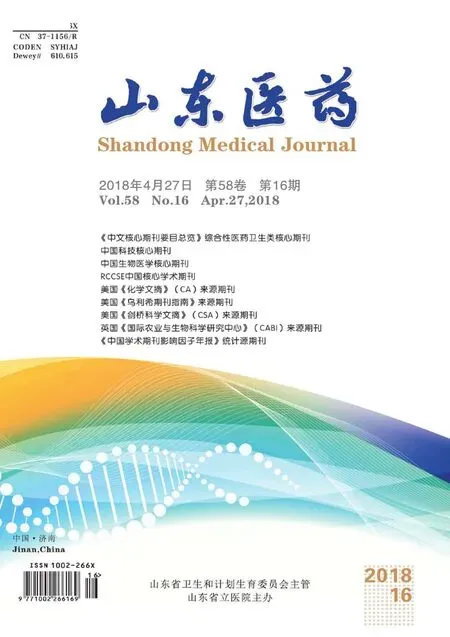巨噬细胞移动抑制因子在自身免疫性疾病发病中作用的研究进展
杜向荣,宋守君,薛海波(滨州医学院附属医院,山东滨州256600)
巨噬细胞移动抑制因子(MIF)是人体22号染色体长臂(22q11.2)的单一基因编码,是由114个氨基酸组成的大小为12 kD的肽单体,血浆浓度为0.1~300 ng/mL,其分泌与皮质醇昼夜周期有关。MIF具有高度的种间同源性,啮齿动物和人的MIF变异体具有90%的同源性[1,2]。MIF是一种促炎性细胞因子,可通过启动固有性和适应性免疫途径介导机体应答感染和应激[3]。MIF可通过与混合受体和非受体的相互作用来发挥生物学效应,其中包括CD74及趋化因子CXC受体2(CXCR2)、CXCR4及CXCR7,其中研究最广泛的是胞外受体CD74[4]。MIF作为趋化因子,可与CXCR2和CXCR4相互作用而影响细胞迁移[5,6]。MIF具有多效生物活性,是临床治疗多种疾病的相关靶点。本研究就MIF在自身免疫性疾病发病中的作用作一综述。
1 MIF在类风湿性关节炎(RA)发病中的作用
RA是一种病因未明的以滑膜炎为主的慢性自身免疫性疾病,病因是由滑膜巨噬细胞及成纤维细胞产生的细胞因子过表达,导致细胞内信号传导途径启动而引发的炎症反应。RA患者血清和滑膜液中MIF水平高于健康人,MIF高表达与骨侵蚀程度和疾病活动度相关。MIF通过促进巨噬细胞和滑膜成纤维细胞释放TNF-α、白细胞介素1(IL-1)、IL-6、IL-8和前列腺素,从而诱导基质金属蛋白酶1(MMP-1)和MMP-3、磷脂酶A2(PLA2)、环氧合酶2(COX-2)表达,导致RA患者炎性反应及滑膜组织退化。MIF也可活化成骨细胞中的MMP-9和MMP-13,而MMP-9和MMP-13可能与RA骨破坏及骨质疏松有关。另外,MIF可通过上调滑膜成纤维细胞MMP-1及MMP-3 mRNA表达,促进RA患者细胞外基质成分降解。MIF也能够诱导人RA滑膜成纤维细胞增殖,并抑制p53表达和凋亡,从而延长细胞存活期[7]。Fan等[8]研究发现,MIF可通过促进转录因子表达和磷酸化作用抑制亮氨酸链(GILZ,也称为tsc22域家族蛋白)表达,GILZ又可调控由MIF介导的MKP-1和MAPK活化。GILZ可通过抑制多种细胞内信号传导发挥抗炎作用,包括NF-κB、启动蛋白1转录因子、Raf-1、Ras和ERK信号通路。Radstake等[9]研究报道,MIF基因多态性虽然与RA患者骨质破坏的发生有关,但是其功能多态性对于RA患者疗效的影响并不大,因此不适合作为RA患者疗效的临床预测指标。
2 MIF在系统性红斑狼疮(SLE)发病中的作用
SLE是一种病因不明的慢性多系统自身免疫性炎性结缔组织病,以自身抗体与免疫复合物沉积导致的靶器官损伤为特点[10]。SLE患者免疫调节异常,包括高敏性B细胞、异常抗体产生以及异常T细胞反应。MIF是B细胞、T细胞、滑膜细胞、内皮细胞和肾小球细胞活化的中介,在SLE发病中具有双重作用。SLE早期MIF基因高表达,并可能通过增强巨噬细胞对于感染因子及免疫复合物的清除能力而降低其早期易感性。在SLE中晚期,MIF低表达可减轻器官损伤,MIF高表达可加重病情[6]。MIF等位基因794 CATT7及173 G/C基因型高表达可加重SLE患者的炎症反应,但是具体的机制及与之相关的临床表现仍未明确[6,11]。新近研究报导,MIF还可能通过影响NF-κB/IκB信号通路参与SLE患者的激素抵抗[12]。
3 MIF在自身免疫性甲状腺疾病(AITD)发病中的作用
AITD是一种典型的器官特异性自身免疫损伤而导致的甲状腺疾病,主要包括桥本甲状腺炎(HT)和Graves病(GD)。Lamki等[13]研究证实,大多数HT或GD患者血清中均存在针对甲状腺抗原的MIF,但尚未有研究发现MIF表达与HT或GD临床表现之间的相关性。Ayaz等[14]以HT患者为研究对象,发现MIF一方面可通过促进Th1细胞因子及炎性因子TNF-α、干扰素α(IFN-α)、IFN-γ、IL-2、IL-6等产生,从而介导产生B淋巴细胞抗原、细胞毒性T细胞和巨噬细胞在甲状腺内的浸润及聚集;另一方面,MIF通过抑制p53依赖的细胞凋亡,促进T细胞增殖和活化,从而增强抗体依赖、细胞因子介导和细胞凋亡对于甲状腺细胞的破坏。研究发现,MIF可能通过与Th17之间的相互作用参与甲状腺自身免疫损伤,并且随着自身免疫损伤的进展呈动态变化,与器官特异性甲状腺自身免疫抗体滴度呈正相关关系[15]。
4 MIF在ANCA相关性血管炎(AAV)发病中的作用
AAV是一组累及全身多系统的自身免疫性疾病,其特点是系统性血管炎及针对PR3、髓过氧化物酶的ANCA共同存在,可分为肉芽肿血管炎、显微镜下多血管炎和嗜酸性肉芽肿血管炎[1]。AAV的发病机制尚不明确,但是细胞因子及ANCA致敏中性粒细胞的启动作用是AAV的发病核心。中性粒细胞可能通过替代途径启动补体的细胞毒作用,导致坏死性血管炎,是AAV的病理性标志[16]。Becker等[17]研究证明,AAV患者血清MIF水平升高,特别是处于疾病活动期的患者。MIF可通过增加ANCA抗原的迁移诱导及启动中性粒细胞,导致呼吸爆发及脱颗粒。AAV患者血清MIF水平升高可促进TNF-α产生和Th1反应,是诱导Th1型免疫反应启动和维持的一个关键因子。
5 MIF在炎症性肠病(IBD)发病中的作用
IBD是一种原因不明的高异质性慢性疾病,包括克罗恩病(CD)和溃疡性结肠炎(UC)。IBD患者和结肠炎患者血清MIF水平均升高,结肠炎动物模型中被上皮细胞和免疫细胞浸润的大肠组织MIF表达明显升高。此外,通过抗体阻断MIF的生物学活性可显著降低结肠炎小鼠大肠组织TNF-α、IFN-γ和MMP等炎性介质表达[18]。MIF可进一步促进IL-6、IL-12产生,这两种细胞因子可通过启动TH1细胞和中性粒细胞等炎症细胞促进炎症发展,在结肠炎的发病过程中具有重要作用。巨细胞生成的MIF与结肠细菌的LPS结合,将进一步促进固有免疫细胞产生更多的TNF-α和NO等炎性介质。
多项研究证实,MIF基因多态性与IBD发病相关。CD患者血清mif-173 CC基因型频率明显高于健康人群,提示mif-173 CC基因型可能与CD易感性有关[19]。Griga等[20]研究证实,CD患者MIF多态性对于糖皮质激素的抗炎效果具有反调节作用。研究发现,MIF启动子CATT序列重复可能与UC的发生、发展密切相关,并且与患者的炎症程度呈正相关关系[21]。Meta分析结果显示,携带MIF-173 G/C多态性的亚洲人罹患IBD的风险升高,而携带MIF-173 G/C多态性的白种人IBD发病风险并不会升高,说明MIF基因多态性与IBD的关系明显存在的人种区别。有研究对IBD类型进行亚组分析发现,MIF-173 G/C多态性可导致UC发病风险明显升高[22]。
6 MIF在系统性硬化症(SSc)发病中的作用
SSc是一种以皮肤和内脏纤维化、明显血管病变及免疫系统失调为特点的不明原因的全身免疫性疾病,该病早期主要为淋巴细胞和巨噬细胞活化,这些细胞释放的细胞因子可促进血管损伤和组织纤维化。SSc患者血清及皮肤组织中MIF表达升高,并且纤维母细胞在分化为成纤维细胞的过程中可分泌MIF,MIF进一步通过抑制p53、活化诱导细胞凋亡来维持炎性反应,可能是SSc造成病变组织纤维增生障碍的主要原因之一。Stefanantoni等[23]研究发现,MIF可通过诱导肺动脉平滑肌细胞增殖及人肺动脉收缩而导致肺动脉压升高。
7 MIF在自身免疫性肝炎(AIH)发病中的作用
AIH是一种由于自身免疫耐受损伤导致肝细胞破坏的慢性、进行性肝脏炎性疾病。近期研究发现,AIH患者血清及肝脏组织中MIF表达明显升高,且依据MIF的功能多态性可将AIH与胆汁淤积性肝硬化等其他疾病相鉴别,由此可见MIF在AIH的炎症级联反应中发挥重要作用[24]。MIF可以启动机体固有性免疫及获得性免疫,特别是Th1细胞免疫,是AIH发病的重要机制之一。Nakajima等[25]研究证实,MIF可通过启动T细胞而加重肝细胞损伤。同时,AIH患者肝脏内MIF受体CD74表达升高,CD74是Ⅱ型跨膜受体,通过CD44招募或者与趋化因子受体结合而启动MIF信号转导[3]。
综上所述,MIF在RA、SLE、AITD、AAV、IBD、SSc、AIH等自身免疫性疾病的发病中均发挥重要作用,MIF、MIF多态性及其受体CD74可能是上述自身免疫性疾病的潜在免疫炎症标记物。
参考文献:
[1] Hao J, Lv TG, Wang C, et al. Macrophage migration inhibitory factor contributes to anti-neutrophil cytoplasmic antibody-induced neutrophils activation[J]. Hum Immunol, 2016,77(12):1209-1214.
[2] Bloom J, Sun S. MIF, a controversial cytokine: a review of structural features, challenges, and opportunities for drug development[J]. Expert Opin Ther Targets, 2016,20(12):1463-1475.
[3] Assis DN, Takahashi H, Leng L, et al. A macrophage migration inhibitory factor polymorphism is associated with autoimmune hepatitis severity in US and Japanese patients[J]. Dig Dis Sci, 2016,61(12):3506-3512.
[4] Spencer ES, Dale EJ, Gommans AL, et al. Multiple binding modes of isothiocyanates that inhibit macrophage migration inhibitory factor[J]. Eur J Med Chem, 2015,93:501-510.
[5] Singh AK, Pantouris G, Borosch S, et al. Structural basis for decreased induction of class IB PI3-kinases expression by MIF inhibitors[J]. J Cell Mol Med, 2017,21(1):142-153.
[6] De la Cruz-Mosso U, Bucala R, Palafox-Sánchez CA, et al. Macrophage migration inhibitory factor: association of -794 CATT5-8 and -173 G>C polymorphisms with TNF-α in systemic lupus erythematosus[J]. Hum Immunol, 2014,75(5):433-439.
[7] Kim KW, Kim HR. Macrophage migration inhibitory factor: a potential therapeutic target for rheumatoid arthritis[J]. Korean J Intern Med, 2016,31(4):634-642.
[8] Fan H, Kao W, Yang YH, et al. Macrophage migration inhibitory factor inhibits the antiinflammatory effects of glucocorticoids via glucocorticoid-induced leucine zipper[J]. Arthritis Rheumatol, 2014,66(8):2059-2070.
[9] Radstake TR, Fransen J, Toonen EJ, et al. Macrophage migration inhibitory factor polymorphisms do not predict therapeutic response to glucocorticoids or to tumour necrosis factor alpha-neutralising treatments in rheumatoid arthritis[J]. Ann Rheum Dis, 2007,66(11):1525-1530.
[10] Feng X, Chen W, Xiao L, et al. Artesunate inhibits type Ⅰ interferon-induced production of macrophage migration inhibitory factor in patients with systemic lupus erythematosus[J]. Lupus, 2017,26(1):62-72.
[11] Lang T, Foote A, Lee JP, et al. MIF: implications in the pathoetiology of systemic lupus erythematosus[J]. Front Immunol, 2015,6:577.
[12] Wang FF, Zhu LA, Zou YQ, et al. New insights into the role and mechanism of macrophage migration inhibitory factor in steroid-resistant patients with systemic lupus erythematosus[J]. Arthritis Res Ther, 2012,14(3):103.
[13] Lamki L, Row VV. Cell-mediated immunity in Graves′ disease and in Hashimoto′s thyroiditis as shown by the demonstration of migration inhibition factor (MIF)[J]. J Clin Endocrinol Metab, 1973,36(2):358-364.
[14] Ayaz T, Sahin SB, Sahin OZ, et al. Serum macrophage migration inhibitory factor levels in Hashimoto′s thyroiditis; a case control study[J]. Thyroid Res, 2014,7(1):11.
[15] Xue H, Yang Y, Zhang Y, et al. Macrophage migration inhibitory factor interacting with Th17 cells may be involved in the pathogenesis of autoimmune damage in Hashimoto′s thyroiditis[J]. Mediators Inflamm, 2015,2015:621072.
[16] Wendt M, Brjesson O, Avik A, et al. Macrophage migration inhibitory factor (MIF) and thyroid hormone alterations in antineutrophil cytoplasmic antibody (ANCA)-associated vasculitis (AAV)[J]. Mol Med, 2013,19(1):109.
[17] Becker H, Maaser C, Mickholz E, et al. Relationship between serum levels of macrophage migration inhibitory factor and the activity of antineutrophil cytoplasmic antibody-associated vasculitides[J]. Clin Rheumatol, 2006,25(3):368-372.
[18] Przybyowska K, Mrowicki J, Sygut A, et al. Contribution of the-173 G/C polymorphism of macrophage migration inhibitory factor gene to the risk of inflammatory bowel diseases[J]. Pol Przegl Chir, 2011,83(2):76-80.
[19] Yun J, Xu CT, Pan BR. Epidemiology and gene markers of ulcerative colitis in the Chinese[J]. World J Gastroenterol, 2009,15(7):788-803.
[20] Griga T, Wilkens C, Wirkus N, et al. A polymorphism in the macrophage migration inhibitory factor gene is involved in the genetic predisposition of Crohn′s disease and associated with cumulative steroid doses[J]. Hepatogastroenterology, 2007,54(75):784-786.
[21] Fei BY, Lv HX, Yang JM. Association of MIF-173 gene polymorphism with inflammatory bowel disease in Chinese Han population[J]. Cytokine, 2008,41(1):44-47.
[22] Yang J, Li Y, Zhang X. Meta-analysis of macrophage migration inhibitory factor (MIF) gene -173G/C polymorphism and inflammatory bowel disease (IBD) risk[J]. Int J Clin Exp Med, 2015,8(6):9570-9574.
[23] Stefanantoni K, Sciarra I, Vasile M, et al. Elevated serum levels of macrophage migration inhibitory factor and stem cell growth factor β in patients with idiopathic and systemic sclerosis associated pulmonary arterial hypertension[J]. Reumatismo, 2015,66(4):270-276.
[24] Assis DN, Leng L, Du X, et al. The role of macrophage migration inhibitory factor in autoimmune liver disease[J]. Hepatology, 2014,59(2):580.
[25] Nakajima H, Takagi H, Horiguchi N, et al. Lack of macrophage migration inhibitory factor protects mice against concanavalin A-induced liver injury[J]. Liver Int, 2006,26(3):346-351.

